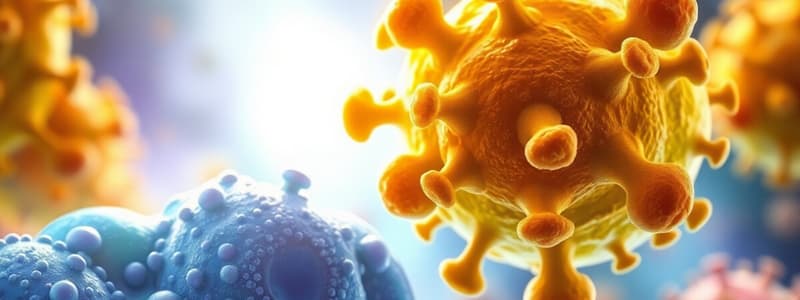Podcast
Questions and Answers
Which mechanism is primarily associated with bactericidal antibiotics?
Which mechanism is primarily associated with bactericidal antibiotics?
- Inhibition of cell wall synthesis (correct)
- Inhibition of nucleic acid synthesis
- Inhibition of folic acid synthesis
- Inhibition of protein synthesis
Which of the following antibiotics is known as a beta-lactam antibiotic?
Which of the following antibiotics is known as a beta-lactam antibiotic?
- Tetracycline
- Penicillin (correct)
- Chloramphenicol
- Erythromycin
Which of the following antibiotics inhibits protein synthesis?
Which of the following antibiotics inhibits protein synthesis?
- Sulfonamide
- Polymyxin
- Streptomycin (correct)
- Neomycin (correct)
What is a common resistance mechanism that bacteria may develop against antibiotics?
What is a common resistance mechanism that bacteria may develop against antibiotics?
Which class of antibiotic is typically bacteriostatic?
Which class of antibiotic is typically bacteriostatic?
What is the primary action of sulfonamides on bacteria?
What is the primary action of sulfonamides on bacteria?
How do sulfonamides exert their effect against bacteria?
How do sulfonamides exert their effect against bacteria?
What is the consequence of excess PABA in the presence of sulfonamides?
What is the consequence of excess PABA in the presence of sulfonamides?
Which enzyme is inhibited by trimethoprim to block folic acid formation?
Which enzyme is inhibited by trimethoprim to block folic acid formation?
What is the primary mechanism of action for penicillins?
What is the primary mechanism of action for penicillins?
Which of the following is a characteristic of bacterial resistance to sulfonamides?
Which of the following is a characteristic of bacterial resistance to sulfonamides?
Which form of bacteria is associated with lysis due to penicillins?
Which form of bacteria is associated with lysis due to penicillins?
What effect does adding side chains to penicillin have?
What effect does adding side chains to penicillin have?
What is the primary mode of action of cephalosporins?
What is the primary mode of action of cephalosporins?
Which of the following is a feature that distinguishes cephalosporins from penicillin?
Which of the following is a feature that distinguishes cephalosporins from penicillin?
What is the outcome of tetracycline binding to the 30S ribosomal subunit?
What is the outcome of tetracycline binding to the 30S ribosomal subunit?
What is a common resistance mechanism against aminoglycosides?
What is a common resistance mechanism against aminoglycosides?
What complication can arise from prolonged use of chloramphenicol?
What complication can arise from prolonged use of chloramphenicol?
Which class of antibiotics primarily inhibits the function of DNA gyrase?
Which class of antibiotics primarily inhibits the function of DNA gyrase?
Which antibiotic is known to cause liver damage as a complication?
Which antibiotic is known to cause liver damage as a complication?
What is the action of macrolides on the ribosome?
What is the action of macrolides on the ribosome?
Flashcards
Sulfonamides
Sulfonamides
Bacteriostatic drugs that inhibit bacterial growth by competing with PABA, an essential molecule for folic acid synthesis.
Bacteriostatic
Bacteriostatic
Inhibiting bacterial growth.
PABA
PABA
Para-aminobenzoic acid, a crucial metabolite in folic acid synthesis in many bacteria
Folic Acid
Folic Acid
Signup and view all the flashcards
Penicillins
Penicillins
Signup and view all the flashcards
Peptidoglycans
Peptidoglycans
Signup and view all the flashcards
Cell Wall Synthesis
Cell Wall Synthesis
Signup and view all the flashcards
Protoplast (Spheroplast)
Protoplast (Spheroplast)
Signup and view all the flashcards
Bacterial Resistance
Bacterial Resistance
Signup and view all the flashcards
Antibiotics
Antibiotics
Signup and view all the flashcards
Cephalosporins
Cephalosporins
Signup and view all the flashcards
Bactericidal Antibiotics
Bactericidal Antibiotics
Signup and view all the flashcards
Penicillin Resistance Mechanism
Penicillin Resistance Mechanism
Signup and view all the flashcards
Aminoglycosides
Aminoglycosides
Signup and view all the flashcards
Bacteriostatic Antibiotics
Bacteriostatic Antibiotics
Signup and view all the flashcards
Aminoglycoside Resistance
Aminoglycoside Resistance
Signup and view all the flashcards
Mechanism of action
Mechanism of action
Signup and view all the flashcards
Tetracyclines
Tetracyclines
Signup and view all the flashcards
Antimetabolites
Antimetabolites
Signup and view all the flashcards
Penicillin
Penicillin
Signup and view all the flashcards
Tetracycline Side Effects
Tetracycline Side Effects
Signup and view all the flashcards
Chloramphenicol
Chloramphenicol
Signup and view all the flashcards
Streptomycin
Streptomycin
Signup and view all the flashcards
Cephalosporin
Cephalosporin
Signup and view all the flashcards
Macrolides
Macrolides
Signup and view all the flashcards
Polymyxin
Polymyxin
Signup and view all the flashcards
Quinolones
Quinolones
Signup and view all the flashcards
Neomycin
Neomycin
Signup and view all the flashcards
Erythromycin
Erythromycin
Signup and view all the flashcards
Tetracyclines
Tetracyclines
Signup and view all the flashcards
Sulfonamides
Sulfonamides
Signup and view all the flashcards
Chloramphenicol
Chloramphenicol
Signup and view all the flashcards
Study Notes
Antimicrobial Agents
- Antimicrobial agents are substances that kill or inhibit the growth of microorganisms.
- Antibiotics are a type of antimicrobial substance produced by living microorganisms.
- In 1877, Pasteur and Joubert observed that airborne contaminants had a lethal effect on Bacillus anthracis.
- In 1929, Alexander Fleming observed that the fungus Penicillium notatum inhibited the growth of staphylococci.
- Chain, Florey, and associates developed penicillin preparations with high antibacterial therapy but low toxicity for humans and animals.
- A major source of antibiotics is Streptomyces.
- Antibiotics are classified by their effect on bacteria.
- Bactericidal antibiotics kill bacteria.
- Examples include penicillin, streptomycin, cephalosporin, polymyxin, neomycin, and erythromycin.
- These have a rapid lethal effect in high concentrations.
- Bacteriostatic antibiotics inhibit bacterial growth.
- Examples include tetracyclines, sulfonamides, and chloramphenicol.
- Some can be both.
- Bactericidal antibiotics kill bacteria.
Mechanism of Action
-
Sulfonamides are bacteriostatic, inhibiting the growth of bacteria by acting as structural analogs of PABA.
- PABA is essential for the synthesis of folic acid, an essential metabolite for bacteria.
- Sulfonamides compete with PABA, hindering folic acid synthesis and consequently, inhibiting bacterial growth.
- However, they do not affect bacteria that cannot synthesize their own folic acid.
-
Penicillins inhibit the synthesis of cell walls in growing susceptible bacteria.
- Bacteria's cell wall is composed of peptidoglycan.
- Penicillins prevent crosslinking of peptidoglycan, resulting in cell lysis.
- Bacteria that lack cell walls are not affected.
- Different procaine chains can influence the absorption.
-
Cephalosporins are synthetic analogs of penicillin.
- They have a lower toxicity and broader spectrum of activity than penicillins.
- They are effective against gram-positive and gram-negative bacteria.
-
Aminoglycosides inhibit protein synthesis.
- These bind to the 30S ribosomal subunit and interfere with the protein synthesis process within the cell.
- This results in miscodding of proteins and peptide elongation.
- Potential mechanisms cause impaired ribosomal binding, transport, alteration/inactivation of the drug.
- These bind to the 30S ribosomal subunit and interfere with the protein synthesis process within the cell.
-
Tetracyclines inhibit protein synthesis.
- Bind to 30S ribosomal subunits and prevent the function of tRNA, which is crucial for protein production.
- It is bacteriostatic and has a broad spectrum of effectiveness.
- Bind to 30S ribosomal subunits and prevent the function of tRNA, which is crucial for protein production.
-
Chloramphenicol inhibits protein synthesis.
- Binds to 50S ribosomal subunits to suppress protein production.
- Prolonged use may lead to bone marrow depression.
- Binds to 50S ribosomal subunits to suppress protein production.
-
Macrolides (e.g., erythromycin) also inhibit protein synthesis. -Bind to 50S ribosome.
-
Lincosamides (e.g., clindamycin) also inhibit protein synthesis.
- Bind to a 50S ribosomal subunit.
-
Quinolones inhibit certain activities involving DNA.
- Inhibit the bacterial enzyme DNA gyrase, an activity crucial for supercoiling of chromosomal DNA.
- This results in the degradation of DNA; resulting in bacterial death.
- Inhibit the bacterial enzyme DNA gyrase, an activity crucial for supercoiling of chromosomal DNA.
Mechanisms of Drug Resistance
- Mechanisms for drug resistance include changes in outer membrane permeability, alterations in DNA gyrase, altered metabolic pathways, generation of antibiotic destroying enzymes, and alteration in the target.
Studying That Suits You
Use AI to generate personalized quizzes and flashcards to suit your learning preferences.





